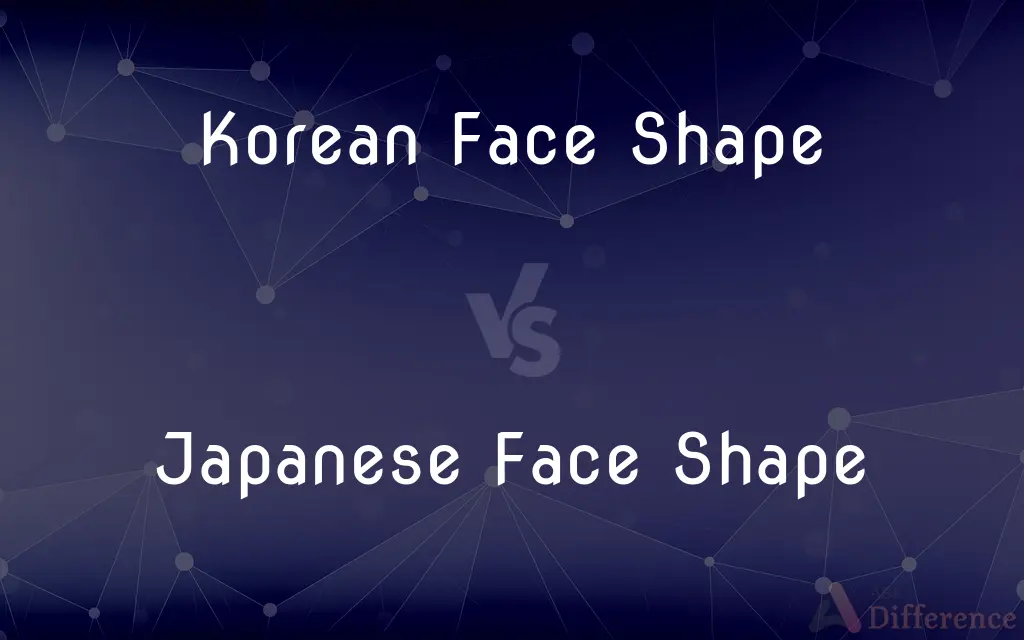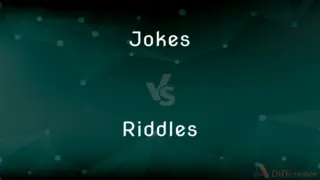Korean Face Shape vs. Japanese Face Shape — What's the Difference?
By Tayyaba Rehman & Urooj Arif — Published on February 2, 2024
Korean face shapes often emphasize a V-shaped or heart-shaped contour, while Japanese face shapes tend to be more oval or longer with subtle contours.

Difference Between Korean Face Shape and Japanese Face Shape
Table of Contents
ADVERTISEMENT
Key Differences
Korean face shapes are frequently characterized by a V-shape or heart-shaped appearance, often with a pointed chin and prominent cheekbones. In contrast, Japanese face shapes commonly exhibit a more oval or elongated form with softer angles and less pronounced cheekbones.
The concept of a 'small face' is a beauty standard in Korea, leading to a preference for a slender, V-shaped facial contour. Conversely, in Japan, a balanced, oval face is often considered ideal, reflecting a different cultural beauty standard.
Korean face shapes might emphasize a youthful, slim appearance with a tapered jawline, aligning with popular beauty trends in Korea. Japanese face shapes, on the other hand, might lean towards a natural, less contoured look, embodying a more classic and subtle beauty ideal.
In the realm of cosmetic procedures, there's a tendency in Korea to alter the face shape to achieve the desired V-shape through techniques like bone shaving. Japanese beauty trends might focus more on enhancing the natural shape, without extensive alterations to the basic structure.
The Korean face shape ideal is often associated with a youthful and refined appearance, while the Japanese face shape ideal leans towards a mature and natural elegance, showcasing the varied beauty standards within these cultures.
ADVERTISEMENT
Comparison Chart
Typical Contour
V-shaped or heart-shaped
Oval or elongated
Chin Feature
Pointed chin
Softer, rounded chin
Cheekbone Prominence
Prominent cheekbones
Subtler cheekbones
Cultural Beauty Standard
Youthful, slim appearance
Balanced, natural appearance
Cosmetic Alteration Tendency
Tendency for altering to V-shape
Enhancing natural shape
Compare with Definitions
Korean Face Shape
A V-shaped or heart-shaped facial contour, common in Korean beauty standards.
Her Korean face shape, with its elegant V-shaped jaw, was highly admired.
Japanese Face Shape
Reflects a mature elegance and natural beauty standard.
The timeless beauty of her Japanese face shape captivated the audience.
Korean Face Shape
Often idealized in Korean media and beauty industry.
Korean face shape ideals have influenced beauty trends globally.
Japanese Face Shape
Celebrated in Japanese culture for its classic and understated elegance.
Japanese face shape ideals have remained consistent over the years, valuing natural beauty.
Korean Face Shape
Reflects a youthful and refined appearance.
His Korean face shape gave him a youthful look despite his age.
Japanese Face Shape
Typically oval or elongated with a soft, natural look.
Her Japanese face shape, oval and harmonious, was considered classically beautiful.
Korean Face Shape
Characterized by a slender jawline and pointed chin.
Korean dramas often feature actors with the desirable Korean face shape.
Japanese Face Shape
Characterized by a more rounded chin and subtle contours.
Actresses in Japanese cinema often have the admired oval Japanese face shape.
Korean Face Shape
Emphasizes prominent cheekbones and a narrow facial width.
The model's Korean face shape added to her photogenic qualities.
Japanese Face Shape
Less emphasis on high cheekbones, preferring a balanced look.
His Japanese face shape with subtle cheekbones gave him a serene appearance.
Common Curiosities
Is the Japanese face shape different from other Asian face shapes?
Yes, the Japanese face shape tends to be more oval and natural compared to other Asian face shapes, which might have different contours.
Do Korean beauty standards influence the perception of face shapes?
Yes, Korean beauty standards greatly influence the perception and idealization of the Korean face shape.
Do Japanese people often undergo surgery to change their face shape?
While cosmetic surgery exists in Japan, there's a stronger emphasis on enhancing natural beauty rather than drastically changing the face shape.
What is a typical Korean face shape?
A typical Korean face shape is V-shaped or heart-shaped, with a pointed chin and prominent cheekbones.
What characterizes a Japanese face shape?
Japanese face shapes are often oval or elongated with softer contours and a more rounded chin.
How do Japanese beauty ideals affect their face shape preference?
Japanese beauty ideals favor a natural, balanced look, which influences the preference for oval or elongated face shapes.
Is there a growing trend in Korea for a specific face shape?
The trend for a V-shaped, slender face has been growing in Korea, aligning with contemporary beauty standards.
How do Korean and Japanese face shapes compare in global beauty standards?
Both Korean and Japanese face shapes are recognized in global beauty standards, each celebrated for their unique aesthetic qualities.
How is the Korean face shape viewed in Korean culture?
In Korean culture, the V-shaped face is often seen as a beauty ideal, signifying youth and elegance.
Are cosmetic procedures common to alter face shapes in Korea?
Yes, cosmetic procedures to achieve a V-shaped face are quite common in Korea.
Can diet and lifestyle affect one's face shape?
Diet and lifestyle can impact overall facial structure, but genetic factors primarily determine face shape.
Are these face shape ideals influenced by media?
Yes, media in both Korea and Japan play a significant role in shaping and promoting these face shape ideals.
Is there a preference for one face shape over the other in the fashion industry?
Preferences in the fashion industry vary, with some favoring the Korean V-shaped face for its youthfulness and others preferring the natural elegance of the Japanese face shape.
Do Japanese face shape ideals change with fashion trends?
Japanese face shape ideals tend to be more consistent, valuing natural and classic beauty over changing fashion trends.
Can people from other ethnicities have Korean or Japanese face shapes?
People from various ethnicities can have face shapes resembling Korean or Japanese ideals, as face shapes are diverse and not limited to one ethnicity.
Share Your Discovery

Previous Comparison
KH/s vs. MH/s
Next Comparison
Jokes vs. RiddlesAuthor Spotlight
Written by
Tayyaba RehmanTayyaba Rehman is a distinguished writer, currently serving as a primary contributor to askdifference.com. As a researcher in semantics and etymology, Tayyaba's passion for the complexity of languages and their distinctions has found a perfect home on the platform. Tayyaba delves into the intricacies of language, distinguishing between commonly confused words and phrases, thereby providing clarity for readers worldwide.
Co-written by
Urooj ArifUrooj is a skilled content writer at Ask Difference, known for her exceptional ability to simplify complex topics into engaging and informative content. With a passion for research and a flair for clear, concise writing, she consistently delivers articles that resonate with our diverse audience.












































